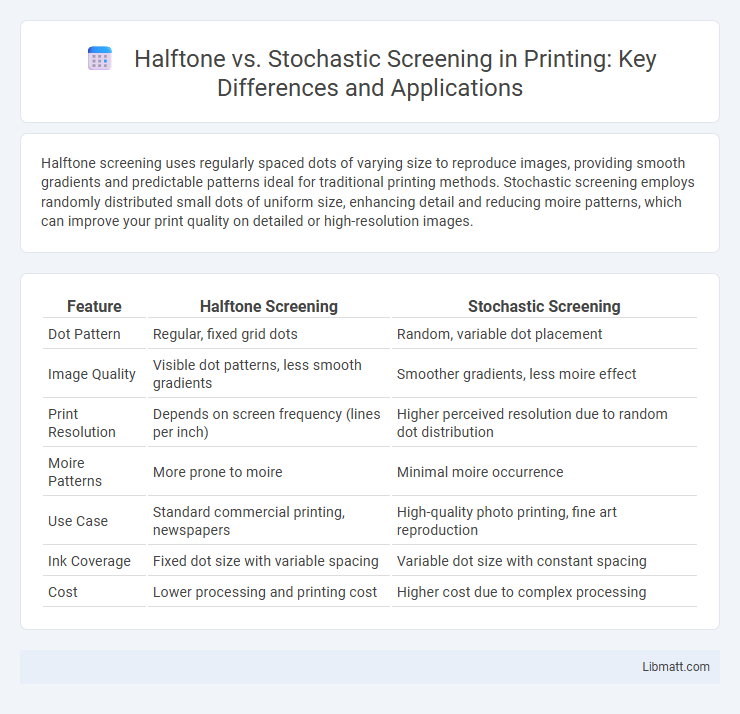Halftone screening uses regularly spaced dots of varying size to reproduce images, providing smooth gradients and predictable patterns ideal for traditional printing methods. Stochastic screening employs randomly distributed small dots of uniform size, enhancing detail and reducing moire patterns, which can improve your print quality on detailed or high-resolution images.
Table of Comparison
| Feature | Halftone Screening | Stochastic Screening |
|---|---|---|
| Dot Pattern | Regular, fixed grid dots | Random, variable dot placement |
| Image Quality | Visible dot patterns, less smooth gradients | Smoother gradients, less moire effect |
| Print Resolution | Depends on screen frequency (lines per inch) | Higher perceived resolution due to random dot distribution |
| Moire Patterns | More prone to moire | Minimal moire occurrence |
| Use Case | Standard commercial printing, newspapers | High-quality photo printing, fine art reproduction |
| Ink Coverage | Fixed dot size with variable spacing | Variable dot size with constant spacing |
| Cost | Lower processing and printing cost | Higher cost due to complex processing |
Introduction to Halftone and Stochastic Screening
Halftone screening uses a grid of uniform dots varying in size to simulate gray levels, primarily employed in traditional offset printing to reproduce continuous-tone images. Stochastic screening, also known as frequency-modulated screening, distributes tiny dots of consistent size randomly, enhancing detail and reducing moire patterns in high-resolution digital printing. Both methods optimize image quality but differ in dot structure and visual effects, impacting print sharpness and texture.
Understanding Halftone Screening
Halftone screening uses a grid of dots varying in size and spacing to simulate continuous-tone images, enabling detailed reproduction in print media. This traditional method controls tonal variation by adjusting dot diameter within fixed cell patterns, ensuring predictable output and compatibility with most printing processes. By contrast, stochastic screening employs randomized dot placement and uniform dot size to enhance detail and reduce moire patterns, but halftone remains essential for controlled tonal transitions in commercial printing.
Fundamentals of Stochastic (FM) Screening
Stochastic screening, also known as Frequency Modulated (FM) screening, uses randomly distributed dots of the same size to create shades and gradients, unlike traditional halftone screening that varies dot size in a fixed grid. This technique improves detail and reduces moire patterns, offering smoother tonal transitions and sharper image quality in print. Your designs benefit from enhanced accuracy and finer texture reproduction when using stochastic screening methods.
Key Differences Between Halftone and Stochastic Screening
Halftone screening uses regularly spaced dots of varying sizes to simulate continuous tones, while stochastic screening employs randomly distributed, uniform-sized microdots to create images. Halftone patterns can produce visible moire effects, whereas stochastic screening significantly reduces moire and improves detail in gradients and photographic images. The choice between halftone and stochastic screening impacts print quality, color accuracy, and the ability to reproduce fine details in high-resolution printing applications.
Image Quality Comparison: Detail and Sharpness
Halftone screening produces images with distinct dots arranged in regular patterns, resulting in clear detail but sometimes visible dot structures that can reduce perceived sharpness. Stochastic screening uses randomly distributed microdots, which enhances detail by minimizing moire patterns and producing smoother gradients, improving overall image sharpness. Your choice influences the final print quality, as stochastic screening often delivers finer detail and sharper images compared to traditional halftone methods.
Color Reproduction and Tonal Range
Halftone screening uses fixed dot patterns to reproduce colors, resulting in distinct tonal steps which can limit smooth gradients and subtle color variations. Stochastic screening employs random dot distribution, enhancing color reproduction accuracy and extending the tonal range by minimizing visible patterns and improving detail in highlights and shadows. This method produces finer gradients and more natural color transitions, making it ideal for high-quality print applications requiring precise color fidelity.
Printing Applications for Halftone and Stochastic Methods
Halftone screening is widely used in traditional offset and digital printing, delivering smooth gradients and consistent tones for images in magazines, newspapers, and brochures. Stochastic screening excels in high-resolution inkjet and flexographic printing, producing finer detail and reducing moire patterns, ideal for packaging and high-quality photo reproduction. Your choice between these methods influences print clarity, color fidelity, and suitability for different media types.
Advantages and Limitations of Each Screening Technique
Halftone screening offers precise control over tonal gradations, producing clear and consistent images ideal for traditional printing processes, but it may result in visible dot patterns and moire effects. Stochastic screening utilizes randomly dispersed smaller dots to create smoother gradients and reduce moire, enhancing image detail and depth; however, it requires higher-resolution printing equipment and can be more challenging to reproduce consistently across different presses. Understanding these strengths and limitations helps you select the appropriate screening technique to optimize print quality based on your project's specific needs.
Choosing the Right Screening Method for Your Project
Selecting the appropriate screening method depends on your project's desired print quality and detail. Halftone screening uses regular dot patterns to achieve smooth gradient tones, ideal for high-contrast images and straightforward designs. Stochastic screening employs random, smaller dots that enhance fine detail and reduce moire patterns, making it suitable for complex images and high-resolution printing.
Future Trends in Print Screening Technologies
Future trends in print screening technologies emphasize the integration of AI-driven algorithms to enhance both halftone and stochastic screening accuracy, resulting in improved image quality and color fidelity. Advances in nanotechnology are enabling finer dot placement and greater resolution, pushing the boundaries of traditional halftone patterns while optimizing stochastic screening's random dot distribution for reduced moire effects. Emerging hybrid screening methods combine the predictability of halftone with the randomness of stochastic screening, offering printers enhanced versatility for various substrates and complex graphics.
Halftone vs stochastic screening Infographic

 libmatt.com
libmatt.com